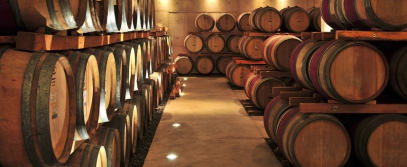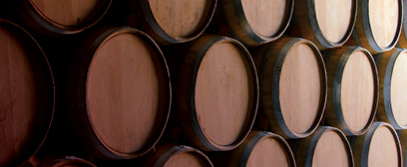California Bulk Wine Trends and Key Considerations for The Asset Based Financing Professional

This article serves as a general guide for lenders when evaluating a prospective borrower or existing portfolio account involved in the California bulk wine industry.
Industry Overview
Wine that is in the process of aging, either in a barrel or tank, or fully aged wine that is stored in tanks, is generally referred to as bulk wine. The bulk wine market varies greatly in condition at any point in time, given wines in this category can range from recently produced and just starting the aging process to ready for bottling.
The bulk wine market in California is generally very active as winemakers often purchase bulk wine to supplement their existing supply or as an overall strategy, rather than purchasing grapes for use in the production of their own wine.
Vintage, varietal, appellation (the location where the grapes are grown), weather, and environmental factors all play a major role in the bulk wine market. Grape yields have been down in recent years, partially due to drought conditions throughout California. This year, however, California saw significant amounts of rain and snow, which is expected to benefit the 2023 crop. For growers, though, even too much of a good thing can be an ongoing concern, requiring careful monitoring as grapes develop for harvest.
Fire is an additional, and highly concerning, environmental factor that presents various issues for the wine industry. In September 2020, the Napa region suffered widespread damage due to fires. In addition to vineyards and wineries being destroyed, those grapes not destroyed by flames were impacted by smoke. When vineyards and grapes are exposed to smoke, wines can take on undesirable sensory characteristics such as “smoky,” “burnt,” “ashy” or “medicinal.” These are usually referred to collectively as “smoke taint.” Many crops had to be destroyed in 2020 due to smoke taint, making bulk wine that was already available on the market highly desirable. Events such as this can significantly affect both demand and price for bulk wine over the short term.
The amount of bulk wine available for sale has increased in recent months. According to Turrentine Brokerage, bulk wine actively for sale in California increased to nearly 19 million gallons as of early March 2023, and there are now more than 10 million gallons of 2022 vintage bulk wine on the market, despite being one of the smallest crops in a decade. This is a result of slowing retail sales at the value-end that are causing some traditional buyers to become sellers.
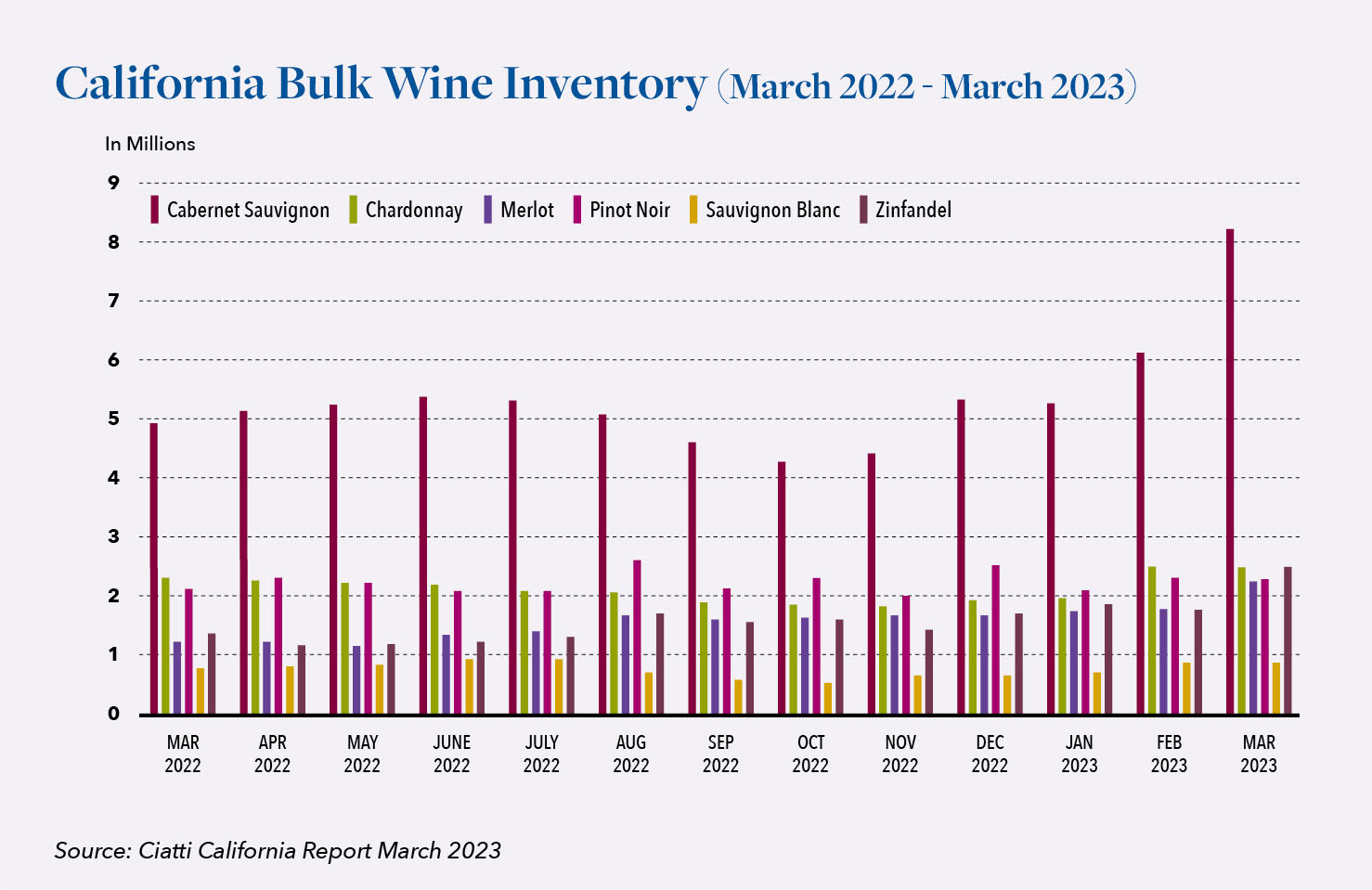
Of the 19 million gallons actively for sale, 12.3 million gallons are California wines; however, only 167,000 gallons are Napa Valley wines. The increased supply means that buyers are not overly motivated to purchase unless they have an immediate need, and high-end buyers are also constrained by lack of sales volume and high prices. Some value-end sellers have lowered their asking price to try to move product, particularly for California Appellation lots, but this does not appear to entice volume buyers to take advantage of the opportunity.
A March 2023 analysis of Cabernet Sauvignon by Turrentine Brokerage illustrates the importance of appellation and how significantly it impacts the value of bulk wine:
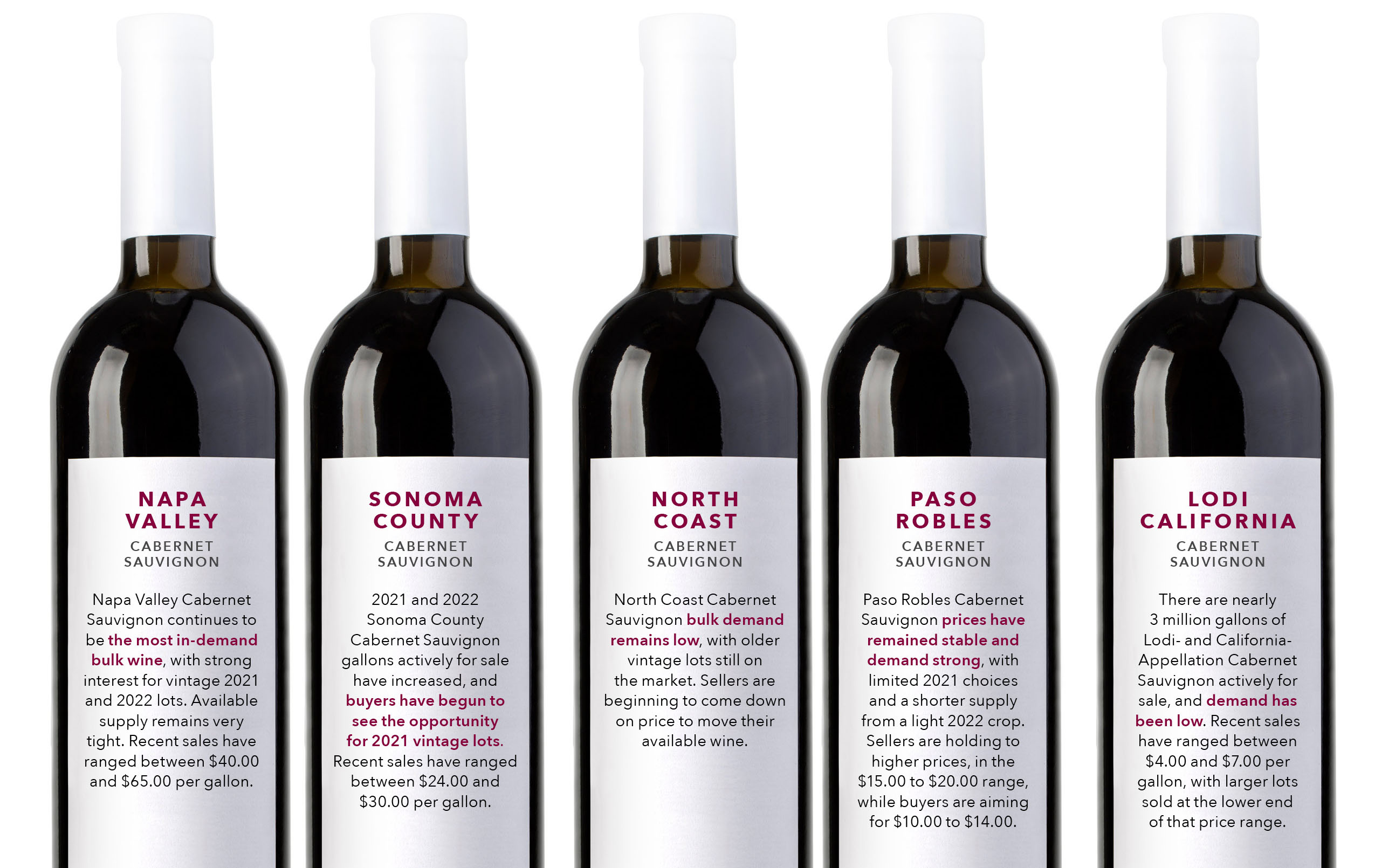
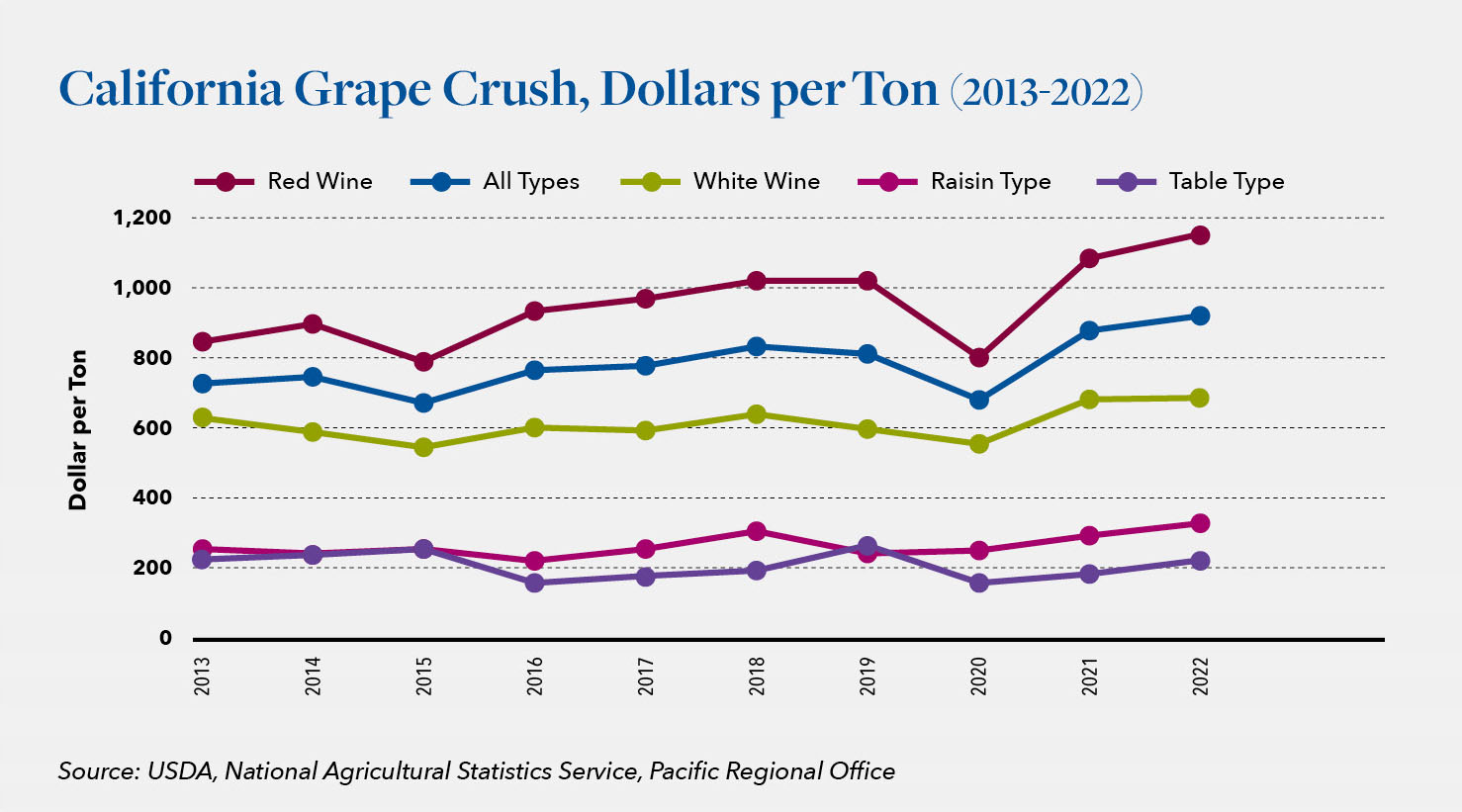
Recommended Due Diligence Discussion Topics
- Seasonality: Wineries typically see a traditional seasonal pattern in bulk wine. Grapes are generally harvested in the fall, immediately crushed, fermented, and further processed, and then aged in barrels or tanks. High-end red wines are traditionally aged in oak barrels for up to 18 months. Lower-end red wines and white wines are generally aged nine to 12 months, but this varies greatly depending on the winemaker, varietal, and many other factors. Wineries often bottle bulk wine in the spring to make room for the upcoming harvest. Given this typical cycle, a lender should expect to see a significant increase in bulk wine in the late fall and early winter, followed by a reduction in the spring once bottling is completed. This, in turn, causes a significant increase in the amount of case goods or bottled wine available for sale in late spring. It should be noted that high-volume, lower-end wines will not see a significant impact due to seasonality because aging times are less and bottling generally takes place year-round.
- Market Pricing: Turrentine Brokerage publishes market pricing that serves as the industry standard for California bulk wine. These reports are published quarterly, for a fee, and provide a high, low, and average likely range for certain vintages and varietals by region. Lenders can purchase these publications and monitor bulk wine pricing each quarter, as needed. Market price is the main factor used when valuing California bulk wine.
- Aging: Although wine generally improves as it ages, this is not true over an extended period of time for all varietals. Red wines typically age the longest, with the highest-end wines aging for an average of 18 months in barrel. Many winemakers then bottle their wine and hold it in bottle for another one or two years before offering it for sale. White wines, on the other hand, are typically never aged longer than nine to 12 months, with the exception of sparkling wines. White wines such as chardonnay and sauvignon blanc are generally meant to be consumed within one to two years from bottling and will not typically improve with age once bottled. Given the typical aging timeframes for the various varietals, bulk white wine that is more than three years old and bulk red wine more than four years old are generally considered to be past their prime and likely would be difficult to sell.
- Volume Limits: Although the bulk wine market fluctuates from year to year based on various factors, there still appear to be limits to what the market can absorb. The liquidation of a significant amount of bulk wine in a relatively short period of time would be difficult given the traditional market constraints. In general, a bulk wine inventory of one million gallons is assumed to be the maximum amount that could be sold through the normal bulk wine channels. Even with significant discounting, it is unlikely that a greater amount would be viable in a traditional liquidation timeframe, absent a significant environmental event. Bulk wine inventories greater than one million gallons would require a less traditional liquidation methodology.
- Costing Methodology: It is important to understand the cost structure for bulk wine, as this can vary significantly between wineries. In most cases, wine purchased on the open market as bulk wine will be costed closer to current market prices, compared to estate wine produced by any given winery. Generally, a winery accrues all costs to farm and harvest the grapes over a one-year period and then allocates all costs to the bulk wine once the harvest is complete. This means that during low-yield years, the costs allocated to the wine are higher than during bumper-crop years. As such, bulk wine cost will be higher when there is less bulk wine to absorb those costs. It is important for a lender to understand that the cost of bulk wine is not indicative of its value in the marketplace, but rather of the crop yields and the winery’s ability to control costs. For this reason, market prices, rather than cost, are generally used to value bulk wine.
- Licenses and Permits: Making and selling wine in California requires specific licenses or permits, depending on the operations of the company. Wineries that are having all production done by third-party custom crush facilities do not require the same licenses as wineries making their own wine from either grown or purchased grapes. The lender should ensure that a company has all necessary licenses or permits, as these would need to remain in place over the course of the entire liquidation timeframe.
- Perishable Agricultural Commodities Act (PACA): The PACA regulations ensure that farmers and growers of fresh fruits and vegetables are paid in a fair and timely manner. PACA regulations define fresh fruits and vegetables as “all produce in fresh form generally considered as perishable fruits and vegetables.”In the event of a default or bankruptcy, a lender could be required to pay agricultural growers. Hilco recommends that reserves be in place for any potential PACA claims.
Glossary Of Terms
As with many industries, wineries have their own language. This glossary of terms is designed to provide the reader with a high-level overview of key terms that are likely to arise in conversations with a client:
- Appellation: A legally defined and protected geographical indication primarily used to identify where the grapes for a wine were grown. The appellation for grapes grown in the United States is often identified by the American Viticultural Area (AVA), which is a grape-growing region with specific geographic or climatic features that distinguish it from the surrounding regions and affect how grapes are grown.
- Estate Wine: Estate wine refers to wine made only from grapes grown in a vineyard that is owned or controlled by the winery. It also means that the wine stayed on the premises during the entire production process, including fermentation, bottling, and aging. Wine made from grapes purchased by an outside grower, or made utilizing a third party to crush or store wine during the aging process, cannot be marketed or sold as estate wine.
- Case Goods: Finished, bottled wine ready to sell is known as case goods. Case goods are generally referred to in case quantities, which includes 12 standard 750-milliliter bottles, also referred to as nine-liter equivalent (9LE).
- Perishable Agricultural Commodities Act (PACA): PACA was enacted in 1930 to regulate the marketing of perishable agricultural commodities in interstate and foreign commerce. The primary purpose of PACA is to prevent unfair and fraudulent conduct in the marketing and selling of perishable agricultural commodities and to ensure that farmers or grower are paid fairly and timely. PACA is administered and regulated by the Agricultural Marketing Service, an agency within the USDA.
- Varietal: Varietal refers to the type of grape that is used in making wine. Some of the most popular varietals of wine include cabernet sauvignon, chardonnay, merlot, pinot noir, and sauvignon blanc.
- Vintage: Vintage is defined as the year in which a wine’s grapes were harvested.



